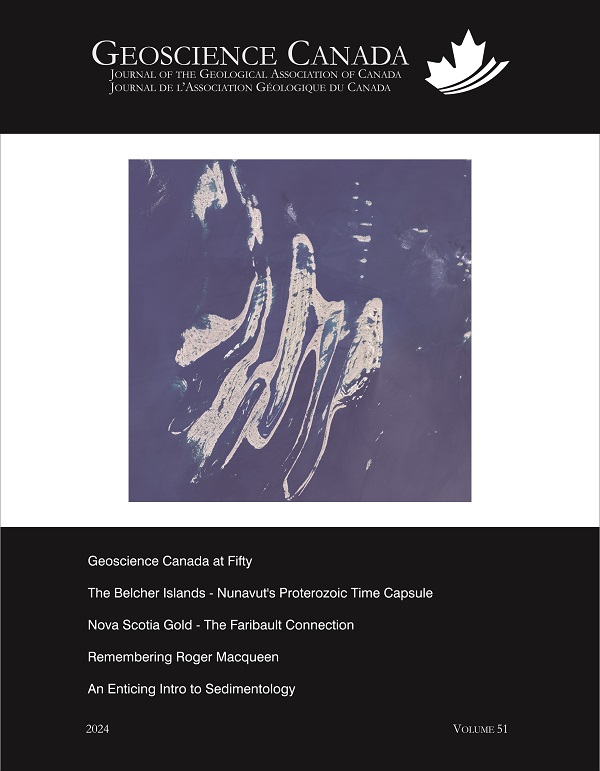Publié-e 2024-04-05
Mots-clés
- Eugène Faribault,
- Gold,
- Icon,
- Nova Scotia
Comment citer
Résumé
Eugène Rodolphe Faribault s'est avéré être un excellent choix en tant que géologue pour la Commission géologique du Canada, après sa nomination le 1er juillet 1883. Sa carrière s'est étalée sur cinquante ans, temps principalement consacré à la cartographie de la moitié sud-ouest de la Nouvelle-Écosse, concentrée sur les ardoises et les quartzites du supergroupe de Meguma dans lequel l'extraction aurifère avait lieu. Selon ses propres termes, il était « un spécialiste des cartes géologiques et de la géologie structurale des mines d'or de la Nouvelle-Écosse ». Des dizaines de ses cartes méticuleusement préparées, couvrant plus de soixante districts aurifères, ont résisté à l’épreuve du temps pour leur exactitude. Figure populaire sur le terrain, Faribault effectuait fréquemment des visites dans les mines en activité. Il reconnut très tôt l'existence, dans certains districts, de vastes gisements de minerai à faible teneur. Il a également souligné les similitudes entre les gisements de type « récifs en selle » (Saddle reef) exploités dans les champs de Bendigo en Australie et les veines aurifères des formations de Meguma. Sa théorie de « zone productrice » soutenait que le minerai exploitable près de la surface dans les mines d’or de la Nouvelle-Écosse devrait se poursuivre en profondeur, à condition que les mêmes conditions structurelles persistent. Cependant, pour diverses raisons, sa théorie reçut un accueil mitigé.
De retour à Ottawa, dans les bureaux de la CGC, Faribault était une figure très respectée tant parmi ses collègues que parmi les superviseurs, et dans tous les départements. Son charisme discret et sa nature amicale, complétés par son expertise professionnelle, lui ont valu des distinctions en tant qu'ambassadeur bien au-delà du lieu de travail. Pour son excellence dans une science en développement, Faribault a pleinement mérité l'épithète de « Grand Spécialiste de la Géologie de la Nouvelle-Écosse ».
Références
- Barkhouse, Joyce, C., 1974, George Dawson, the little giant: Clark Irwin & Company, Toronto.
- Dawson, J.W., 1878, Acadian geology: the geological structure, organic remains and mineral resources of Nova Scotia, New Brunswick, and Prince Edward Island, third edition: MacMillan and Company, London.
- Doggett, M.D., and Mossman, D.J., 1985, Nova Scotia: examining the possibilities of future gold mining: Canadian Mining Journal, v. 3, p. 36–39.
- Faribault, E.R., 1899, The gold measures of Nova Scotia and deep mining: Journal of the Canadian Mining Institute, v. 2, p. 119–129. [Reprinted in 1903 in The Mining Society of Nova Scotia: Halifax, Kings Printer, p. 5–16].
- Faribault, E.R., 1903, Nova Scotia. Deep gold mining. Report on the best methods of testing the value of the deeper gold deposits of Nova Scotia: Government of Nova Scotia, Report, 16 p.
- Faribault, E.R., 1913, The Gold-bearing series of Nova Scotia: International Geological Congress Guide Book No. 1, p. 158–192.
- Faribault, E.R., 1916, Gold-bearing series in northern portions of Queens and Shelburne counties – infusorial earth deposits at Loon Lake Island, Liverpool River, Queens County, Nova Scotia: Geological Survey of Canada, Summary Report 1915, p. 186–192, https://ostrnrcan-dostrncan.canada.ca/handle/1845/107649.
- Faribault, E.R., 1933, Deep saddle-veins seen as a source of wealth in gold: Port and Province, Halifax, October, p. 8–21.
- Faribault, E.R., 1944, Autobiography and bibliography of Dr. E. Rodolphe Faribault: prepared for the Canadian Institute of Mining and Metallurgy’s “Who’s Who”, Ottawa, Ontario, p.104–108.
- Gregory, D.J., 1975, Bibliography of the geology of Nova Scotia: Nova Scotia Department of Mines, Halifax, Nova Scotia, 237 p.
- Hall, E., 1967, Early Canada: A collection of historical photographs by officers of the Geological Survey of Canada: Geological Survey of Canada, Department of Energy, Mines and Resources, Miscellaneous Report 14, 136 p., https://doi.org/10.4095/119934.
- Libbey, W.L., 1905, Government aid to deep gold mining in Nova Scotia: Journal of the Mining Society of Nova Scotia, v. IX, p. 54–71.
- Malcolm, W., 1929, Gold fields of Nova Scotia: Geological Survey of Canada, Memoir 156, 253 p., https://doi.org/10.4095/119968.
- Mossman, D.J., 1982, Nova Scotian gold: The Mineralogical Record, v. 13, p. 335–344.
- Prest, W.H., 1915, The Gold Fields of Nova Scotia: A prospectors handbook, 1st edition (edited by F.P. Ronnan): The Industrial Publishing Company, Ltd., Halifax, NS, 158 p.
- Raddall, T.H., 1968, Footsteps on old floors. True tales of mystery, Chapter 5, The lost gold of Kejimkujik: Double Day & Company, New York, p. 195–218.
- Rand, S.T, 1875, Micmac grammar: a first reading book in the Micmac language: Nova Scotia Publishing Company, Halifax, NS, 252 p., https://doi.org/10.5479/sil.266719.39088005794854.
- Rickard, T.A., 1927, Gold mining in Nova Scotia: Nova Scotia Annual Report on Mines, p.163–177.
- Roy, P.-G., 1913, La famille Faribault: published in Lévis, Québec [publisher not identified], 47 p., https://www.canadiana.ca/view/oocihm.66920.
- Weeks, L.J., 1954, Eugène Rodolphe Faribault: Transactions of the Royal Society of Canada, Section IV, p. 69–73.
- White, C.E., 2010, Stratigraphy of the Lower Paleozoic Goldenville and Halifax groups in southwestern Nova Scotia: Atlantic Geology, v. 46, p. 136–154, https://doi.org/10.4138/atlgeol.2010.008.
- Woodman, J.E., 1902, Geology of the Moose River district, Halifax County, Nova Scotia; together with the pre-Carboniferous history of the Meguma Series: Unpublished PhD thesis, Harvard University, Cambridge, MA, 353 p.
- Zaslow, M., 1975, Reading the rocks: the story of the Geological Survey of Canada 1842–1972: The Macmillan Company of Canada Ltd., Toronto, ON, 599 p., https://doi.org/10.4095/308420.
